child seat GMC CANYON 2005 Owner's Guide
[x] Cancel search | Manufacturer: GMC, Model Year: 2005, Model line: CANYON, Model: GMC CANYON 2005Pages: 420, PDF Size: 2.73 MB
Page 78 of 420
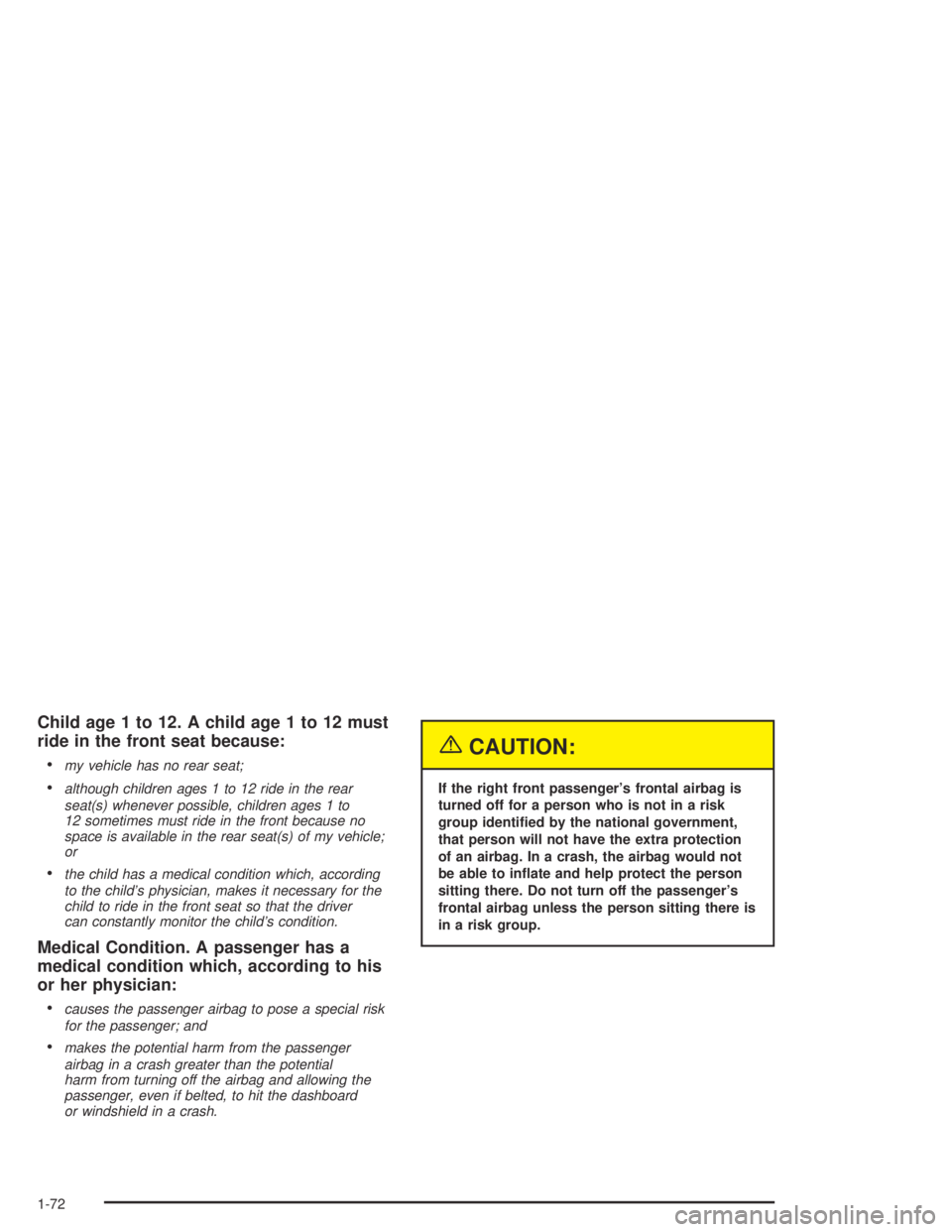
Child age 1 to 12. A child age 1 to 12 must
ride in the front seat because:
my vehicle has no rear seat;
although children ages 1 to 12 ride in the rear
seat(s) whenever possible, children ages 1 to
12 sometimes must ride in the front because no
space is available in the rear seat(s) of my vehicle;
or
the child has a medical condition which, according
to the child’s physician, makes it necessary for the
child to ride in the front seat so that the driver
can constantly monitor the child’s condition.
Medical Condition. A passenger has a
medical condition which, according to his
or her physician:
causes the passenger airbag to pose a special risk
for the passenger; and
makes the potential harm from the passenger
airbag in a crash greater than the potential
harm from turning off the airbag and allowing the
passenger, even if belted, to hit the dashboard
or windshield in a crash.
{CAUTION:
If the right front passenger’s frontal airbag is
turned off for a person who is not in a risk
group identi�ed by the national government,
that person will not have the extra protection
of an airbag. In a crash, the airbag would not
be able to in�ate and help protect the person
sitting there. Do not turn off the passenger’s
frontal airbag unless the person sitting there is
in a risk group.
1-72
Page 79 of 420
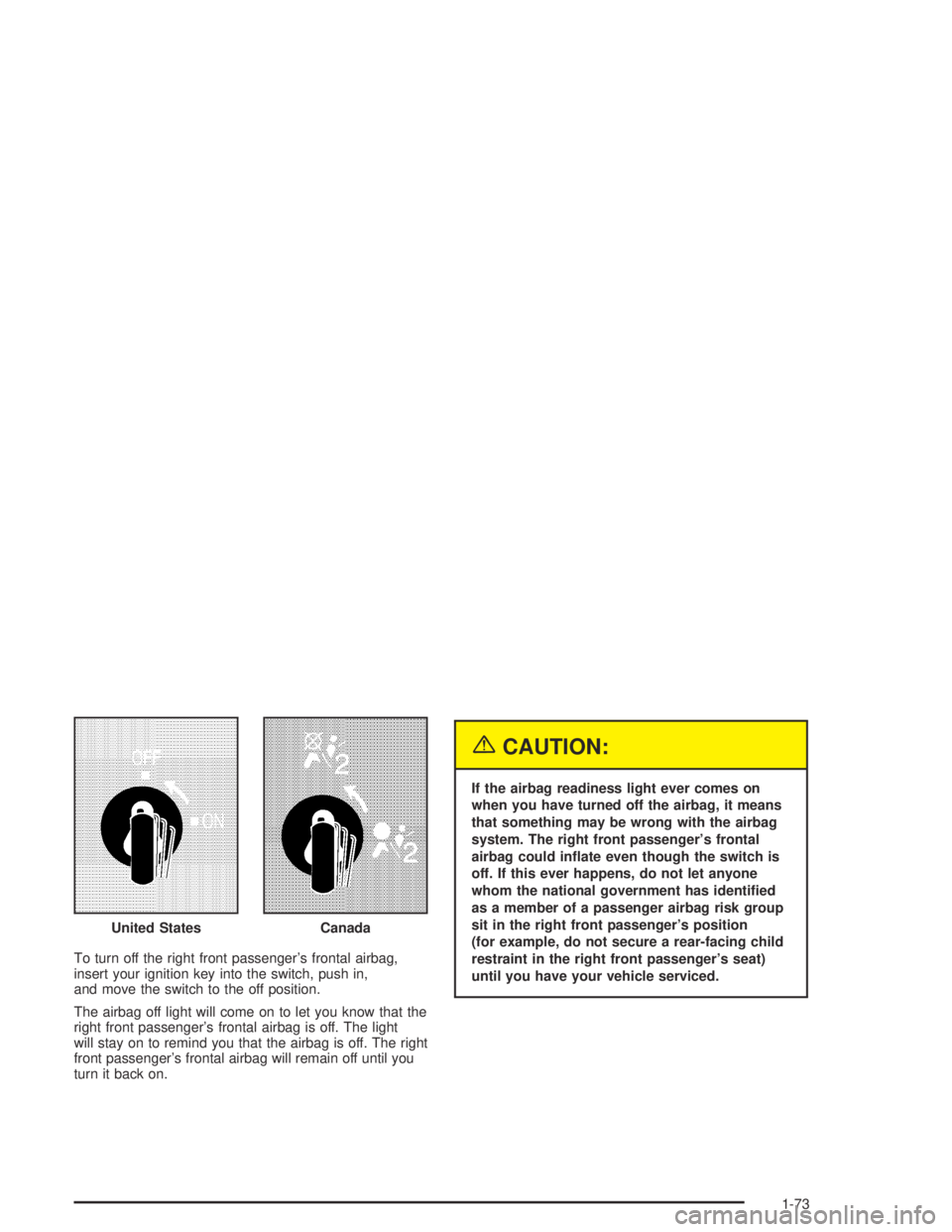
To turn off the right front passenger’s frontal airbag,
insert your ignition key into the switch, push in,
and move the switch to the off position.
The airbag off light will come on to let you know that the
right front passenger’s frontal airbag is off. The light
will stay on to remind you that the airbag is off. The right
front passenger’s frontal airbag will remain off until you
turn it back on.
{CAUTION:
If the airbag readiness light ever comes on
when you have turned off the airbag, it means
that something may be wrong with the airbag
system. The right front passenger’s frontal
airbag could in�ate even though the switch is
off. If this ever happens, do not let anyone
whom the national government has identi�ed
as a member of a passenger airbag risk group
sit in the right front passenger’s position
(for example, do not secure a rear-facing child
restraint in the right front passenger’s seat)
until you have your vehicle serviced. United States
Canada
1-73
Page 153 of 420

{CAUTION:
If the airbag readiness light ever comes on
when you have turned off the airbag, it means
that something may be wrong with the airbag
system. The right front passenger’s frontal
airbag could in�ate even though the switch is
off. If this ever happens, do not let anyone
whom the national government has identi�ed
as a member of a passenger airbag risk group
sit in the right front passenger’s position
(for example, do not secure a rear-facing child
restraint in the right front passenger’s seat)
until you have your vehicle serviced.
Battery Warning Light
This light will come on
brie�y when you start the
vehicle, as a check to
show you it is working;
then it should go out.
If it stays on, or comes on while you are driving, you
may have a problem with the electrical charging system.
Have it checked right away. Driving while this light is
on could drain your battery and result in a vehicle that
may stall. SeeDIC Warnings and Messages on
page 3-41for more information.
If you must drive a short distance with the light on, be
certain to turn off all your accessories, such as the radio
and climate control system.
3-27
Page 250 of 420
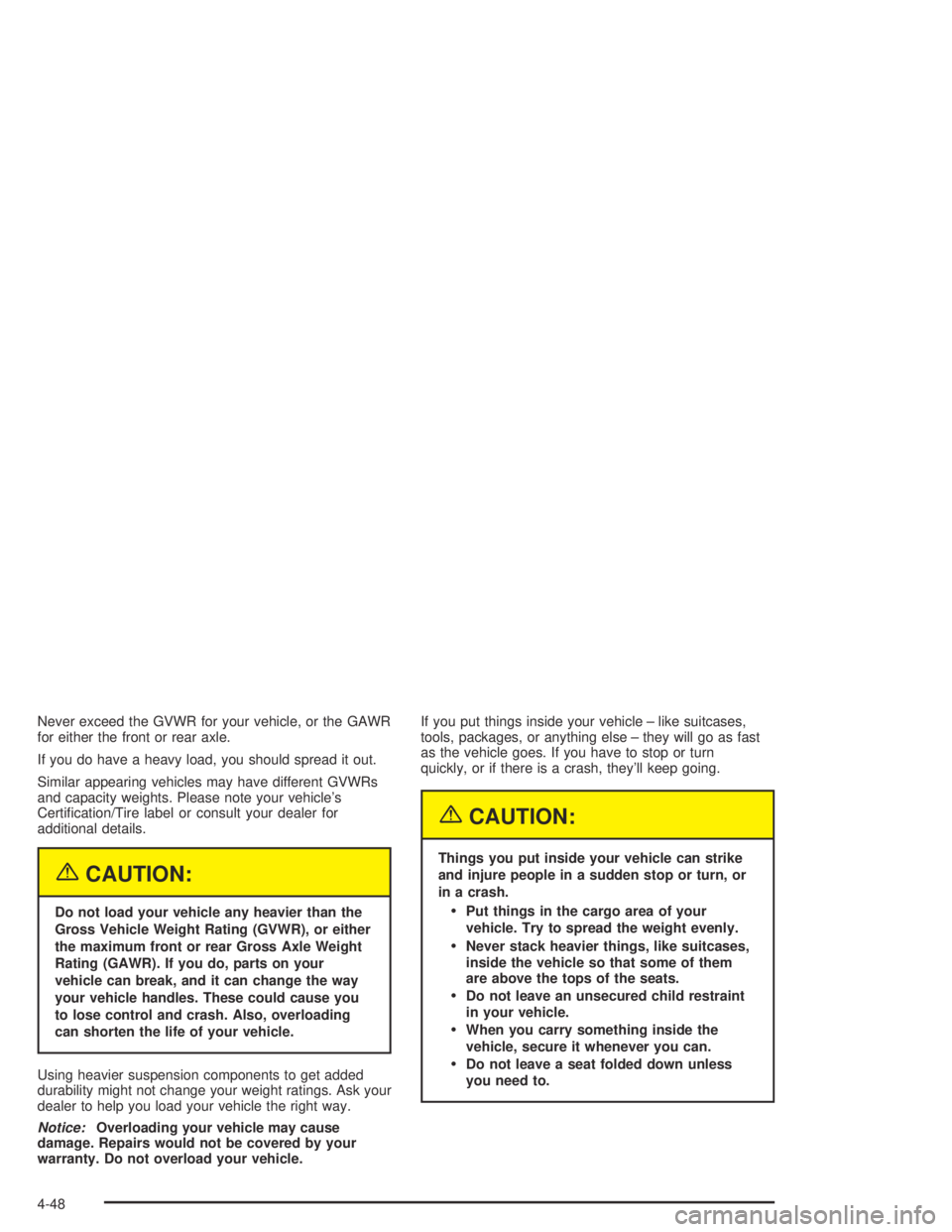
Never exceed the GVWR for your vehicle, or the GAWR
for either the front or rear axle.
If you do have a heavy load, you should spread it out.
Similar appearing vehicles may have different GVWRs
and capacity weights. Please note your vehicle’s
Certi�cation/Tire label or consult your dealer for
additional details.
{CAUTION:
Do not load your vehicle any heavier than the
Gross Vehicle Weight Rating (GVWR), or either
the maximum front or rear Gross Axle Weight
Rating (GAWR). If you do, parts on your
vehicle can break, and it can change the way
your vehicle handles. These could cause you
to lose control and crash. Also, overloading
can shorten the life of your vehicle.
Using heavier suspension components to get added
durability might not change your weight ratings. Ask your
dealer to help you load your vehicle the right way.
Notice:Overloading your vehicle may cause
damage. Repairs would not be covered by your
warranty. Do not overload your vehicle.If you put things inside your vehicle – like suitcases,
tools, packages, or anything else – they will go as fast
as the vehicle goes. If you have to stop or turn
quickly, or if there is a crash, they’ll keep going.
{CAUTION:
Things you put inside your vehicle can strike
and injure people in a sudden stop or turn, or
in a crash.
Put things in the cargo area of your
vehicle. Try to spread the weight evenly.
Never stack heavier things, like suitcases,
inside the vehicle so that some of them
are above the tops of the seats.
Do not leave an unsecured child restraint
in your vehicle.
When you carry something inside the
vehicle, secure it whenever you can.
Do not leave a seat folded down unless
you need to.
4-48
Page 409 of 420
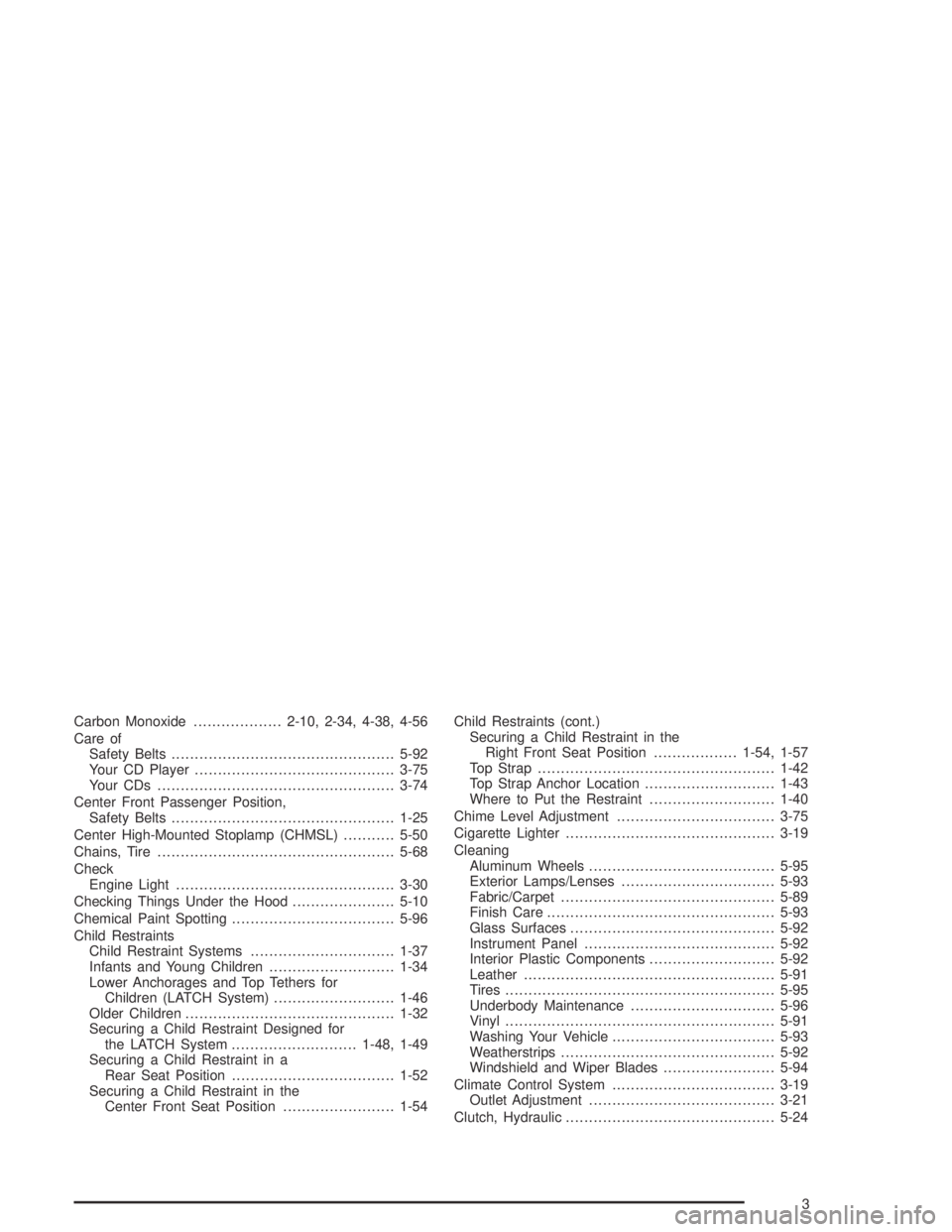
Carbon Monoxide...................2-10, 2-34, 4-38, 4-56
Care of
Safety Belts................................................5-92
Your CD Player...........................................3-75
Your CDs ...................................................3-74
Center Front Passenger Position,
Safety Belts................................................1-25
Center High-Mounted Stoplamp (CHMSL)...........5-50
Chains, Tire...................................................5-68
Check
Engine Light...............................................3-30
Checking Things Under the Hood......................5-10
Chemical Paint Spotting...................................5-96
Child Restraints
Child Restraint Systems...............................1-37
Infants and Young Children...........................1-34
Lower Anchorages and Top Tethers for
Children (LATCH System)..........................1-46
Older Children.............................................1-32
Securing a Child Restraint Designed for
the LATCH System...........................1-48, 1-49
Securing a Child Restraint in a
Rear Seat Position...................................1-52
Securing a Child Restraint in the
Center Front Seat Position........................1-54Child Restraints (cont.)
Securing a Child Restraint in the
Right Front Seat Position..................1-54, 1-57
Top Strap...................................................1-42
Top Strap Anchor Location............................1-43
Where to Put the Restraint...........................1-40
Chime Level Adjustment..................................3-75
Cigarette Lighter.............................................3-19
Cleaning
Aluminum Wheels........................................5-95
Exterior Lamps/Lenses.................................5-93
Fabric/Carpet..............................................5-89
Finish Care.................................................5-93
Glass Surfaces............................................5-92
Instrument Panel.........................................5-92
Interior Plastic Components...........................5-92
Leather......................................................5-91
Tires..........................................................5-95
Underbody Maintenance...............................5-96
Vinyl..........................................................5-91
Washing Your Vehicle...................................5-93
Weatherstrips..............................................5-92
Windshield and Wiper Blades........................5-94
Climate Control System...................................3-19
Outlet Adjustment........................................3-21
Clutch, Hydraulic.............................................5-24
3
Page 413 of 420
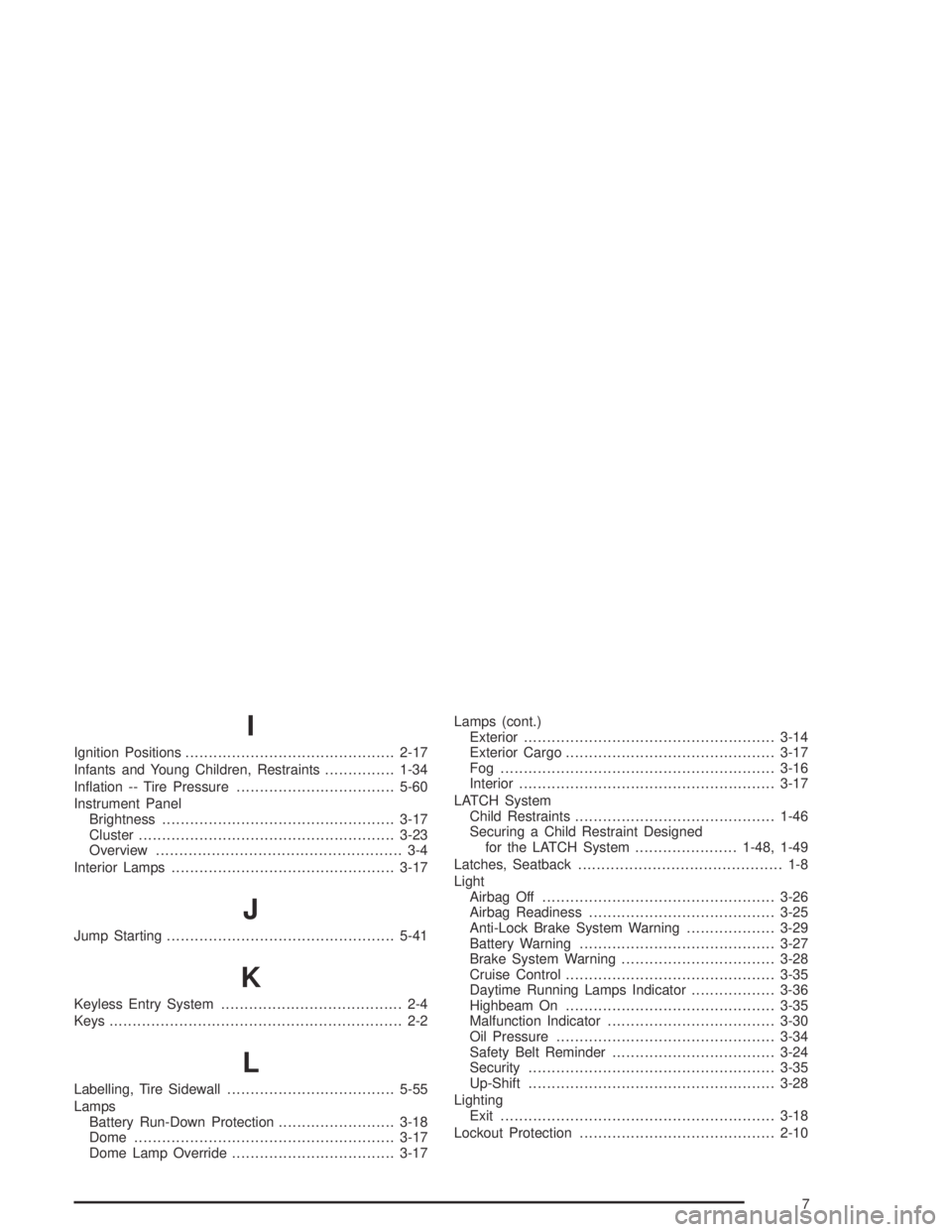
I
Ignition Positions.............................................2-17
Infants and Young Children, Restraints...............1-34
In�ation -- Tire Pressure..................................5-60
Instrument Panel
Brightness..................................................3-17
Cluster.......................................................3-23
Overview..................................................... 3-4
Interior Lamps................................................3-17
J
Jump Starting.................................................5-41
K
Keyless Entry System....................................... 2-4
Keys............................................................... 2-2
L
Labelling, Tire Sidewall....................................5-55
Lamps
Battery Run-Down Protection.........................3-18
Dome........................................................3-17
Dome Lamp Override...................................3-17Lamps (cont.)
Exterior......................................................3-14
Exterior Cargo.............................................3-17
Fog ...........................................................3-16
Interior.......................................................3-17
LATCH System
Child Restraints...........................................1-46
Securing a Child Restraint Designed
for the LATCH System......................1-48, 1-49
Latches, Seatback............................................ 1-8
Light
Airbag Off..................................................3-26
Airbag Readiness........................................3-25
Anti-Lock Brake System Warning...................3-29
Battery Warning..........................................3-27
Brake System Warning.................................3-28
Cruise Control.............................................3-35
Daytime Running Lamps Indicator..................3-36
Highbeam On.............................................3-35
Malfunction Indicator....................................3-30
Oil Pressure...............................................3-34
Safety Belt Reminder...................................3-24
Security.....................................................3-35
Up-Shift.....................................................3-28
Lighting
Exit...........................................................3-18
Lockout Protection..........................................2-10
7
Page 415 of 420
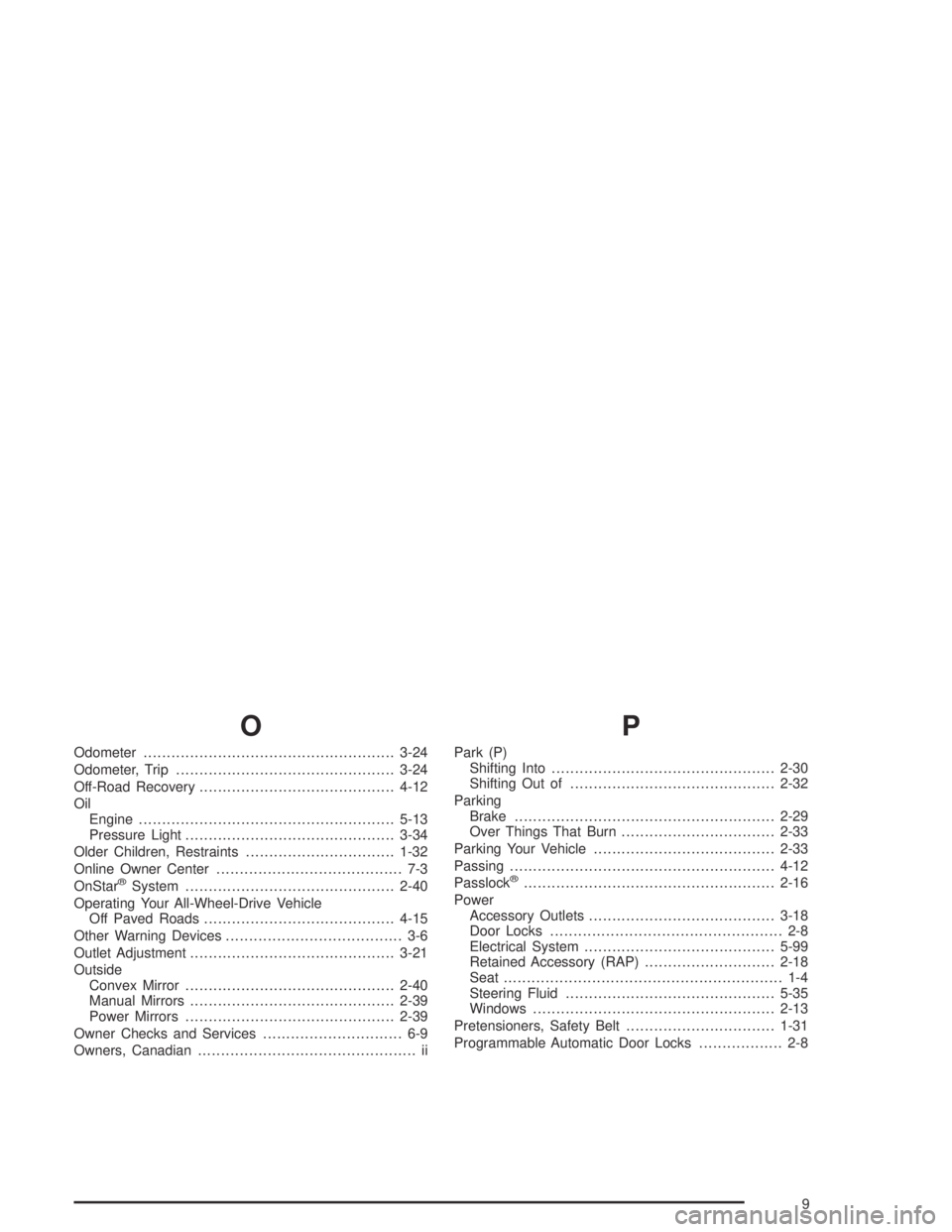
O
Odometer......................................................3-24
Odometer, Trip...............................................3-24
Off-Road Recovery..........................................4-12
Oil
Engine.......................................................5-13
Pressure Light.............................................3-34
Older Children, Restraints................................1-32
Online Owner Center........................................ 7-3
OnStar
®System.............................................2-40
Operating Your All-Wheel-Drive Vehicle
Off Paved Roads.........................................4-15
Other Warning Devices...................................... 3-6
Outlet Adjustment............................................3-21
Outside
Convex Mirror.............................................2-40
Manual Mirrors............................................2-39
Power Mirrors.............................................2-39
Owner Checks and Services.............................. 6-9
Owners, Canadian............................................... ii
P
Park (P)
Shifting Into................................................2-30
Shifting Out of............................................2-32
Parking
Brake........................................................2-29
Over Things That Burn.................................2-33
Parking Your Vehicle.......................................2-33
Passing.........................................................4-12
Passlock
®......................................................2-16
Power
Accessory Outlets........................................3-18
Door Locks.................................................. 2-8
Electrical System.........................................5-99
Retained Accessory (RAP)............................2-18
Seat............................................................ 1-4
Steering Fluid.............................................5-35
Windows....................................................2-13
Pretensioners, Safety Belt................................1-31
Programmable Automatic Door Locks.................. 2-8
9
Page 417 of 420
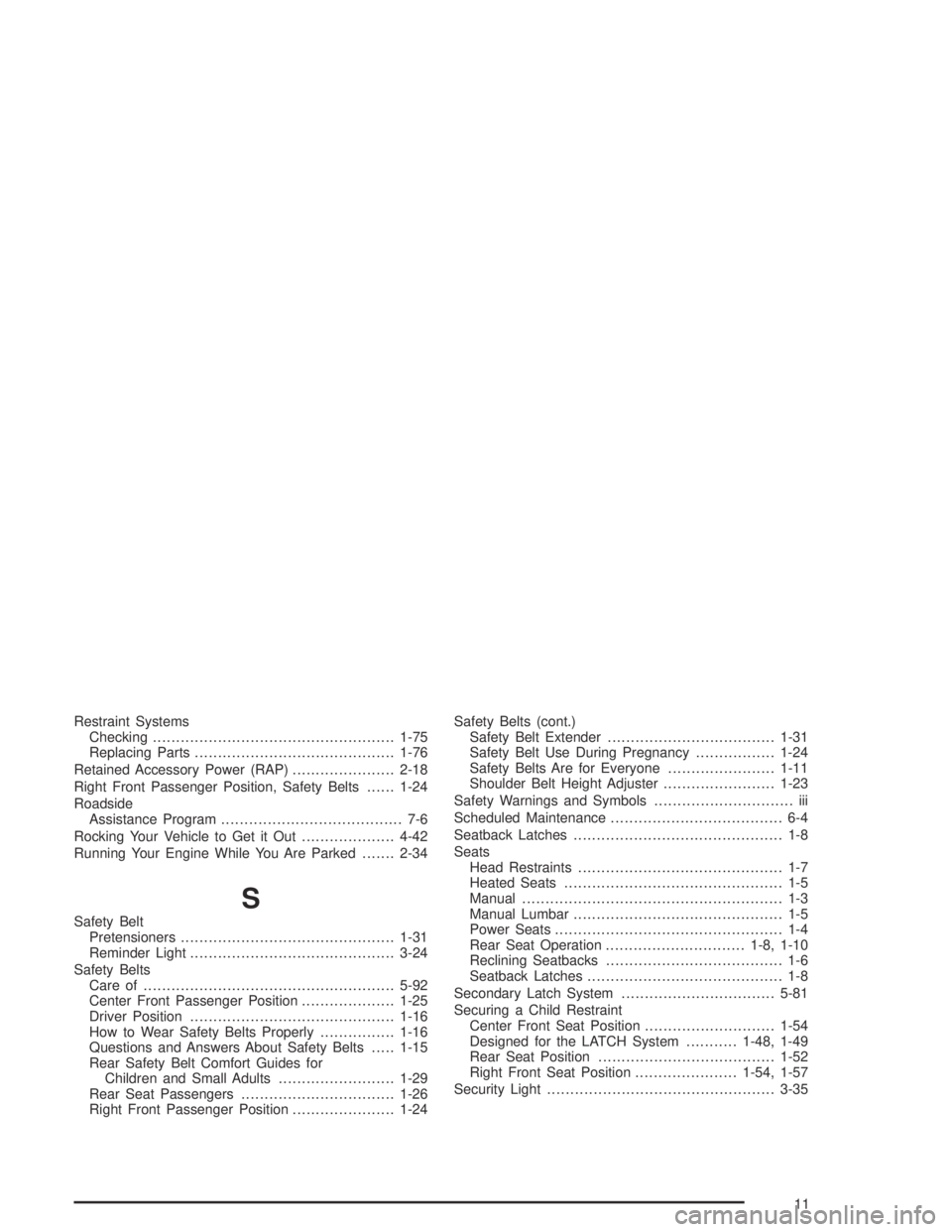
Restraint Systems
Checking....................................................1-75
Replacing Parts...........................................1-76
Retained Accessory Power (RAP)......................2-18
Right Front Passenger Position, Safety Belts......1-24
Roadside
Assistance Program....................................... 7-6
Rocking Your Vehicle to Get it Out....................4-42
Running Your Engine While You Are Parked.......2-34
S
Safety Belt
Pretensioners..............................................1-31
Reminder Light............................................3-24
Safety Belts
Care of......................................................5-92
Center Front Passenger Position....................1-25
Driver Position............................................1-16
How to Wear Safety Belts Properly................1-16
Questions and Answers About Safety Belts.....1-15
Rear Safety Belt Comfort Guides for
Children and Small Adults.........................1-29
Rear Seat Passengers.................................1-26
Right Front Passenger Position......................1-24Safety Belts (cont.)
Safety Belt Extender....................................1-31
Safety Belt Use During Pregnancy.................1-24
Safety Belts Are for Everyone.......................1-11
Shoulder Belt Height Adjuster........................1-23
Safety Warnings and Symbols.............................. iii
Scheduled Maintenance..................................... 6-4
Seatback Latches............................................. 1-8
Seats
Head Restraints............................................ 1-7
Heated Seats............................................... 1-5
Manual........................................................ 1-3
Manual Lumbar............................................. 1-5
Power Seats................................................. 1-4
Rear Seat Operation..............................1-8, 1-10
Reclining Seatbacks...................................... 1-6
Seatback Latches.......................................... 1-8
Secondary Latch System.................................5-81
Securing a Child Restraint
Center Front Seat Position............................1-54
Designed for the LATCH System...........1-48, 1-49
Rear Seat Position......................................1-52
Right Front Seat Position......................1-54, 1-57
Security Light.................................................3-35
11